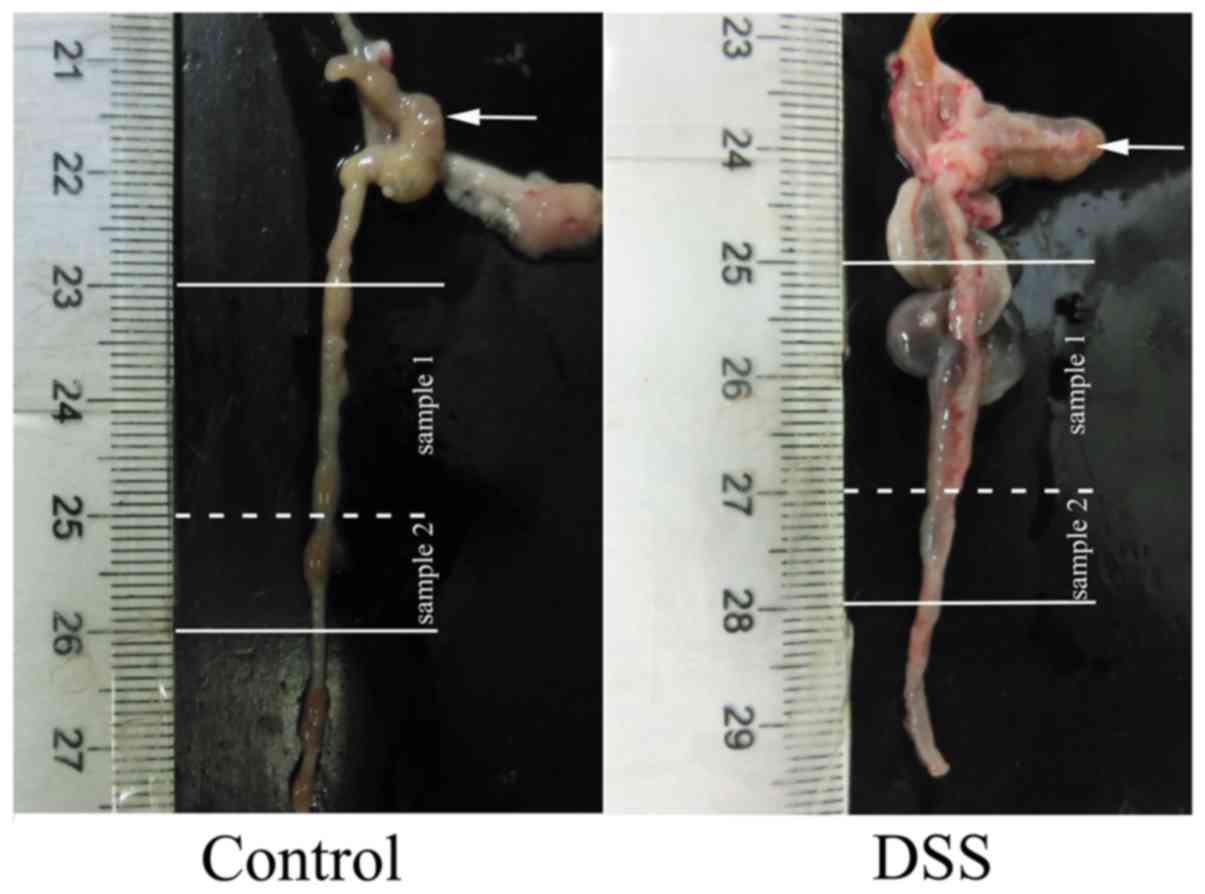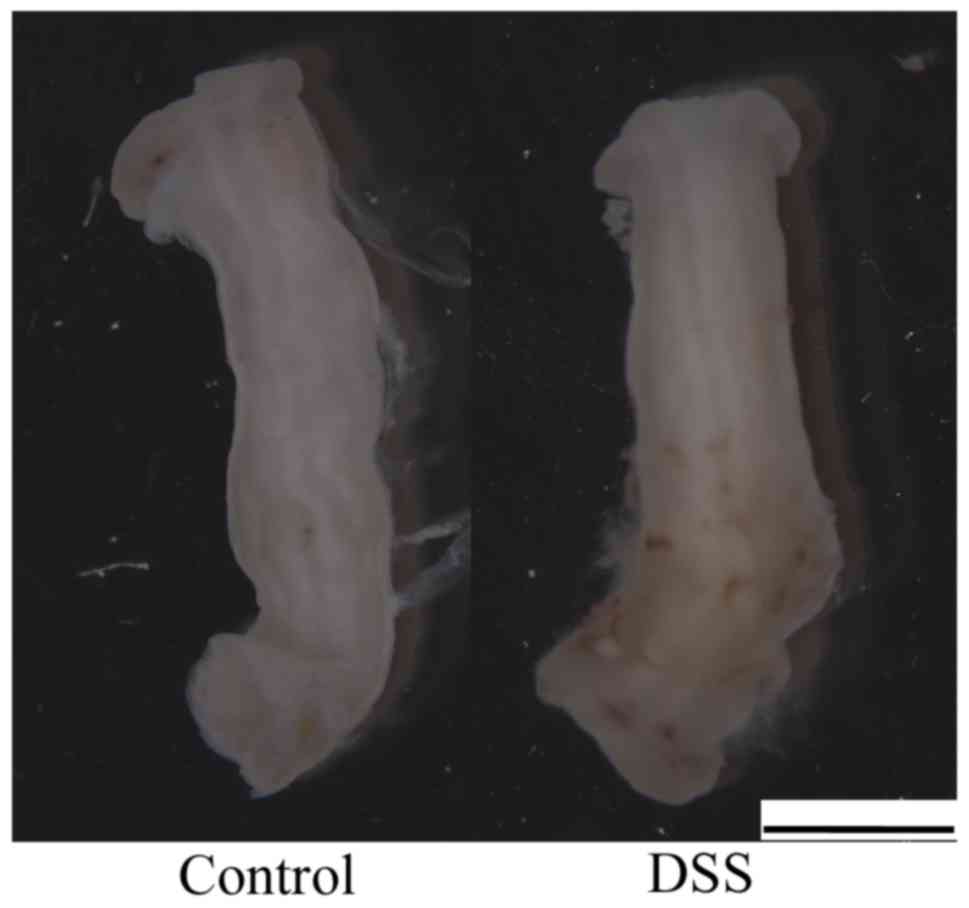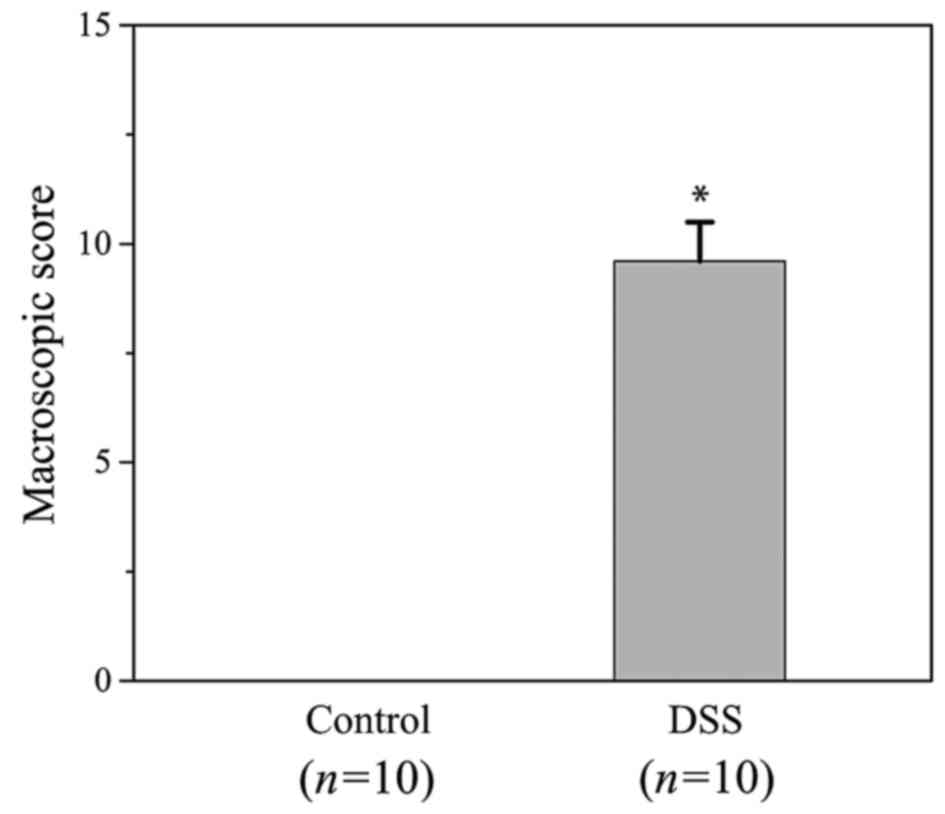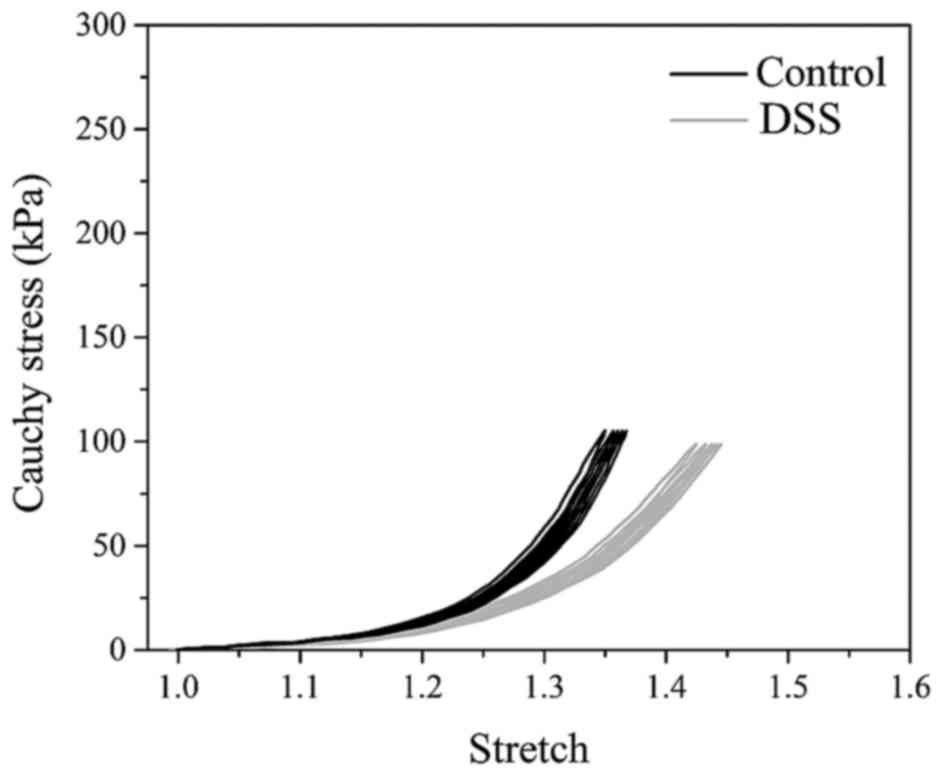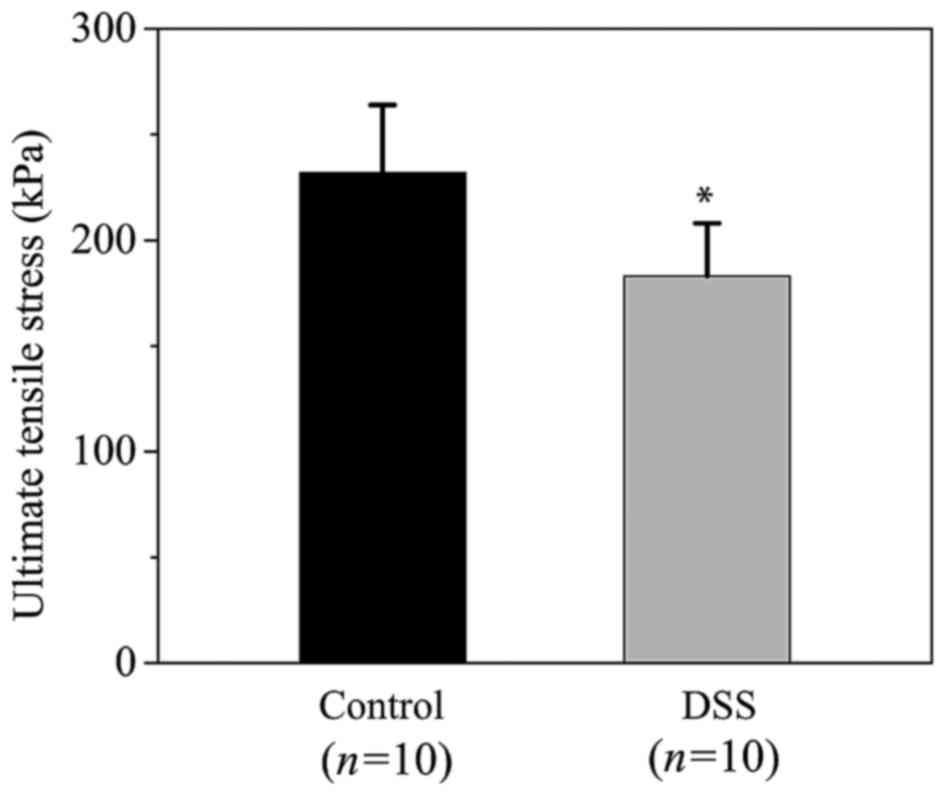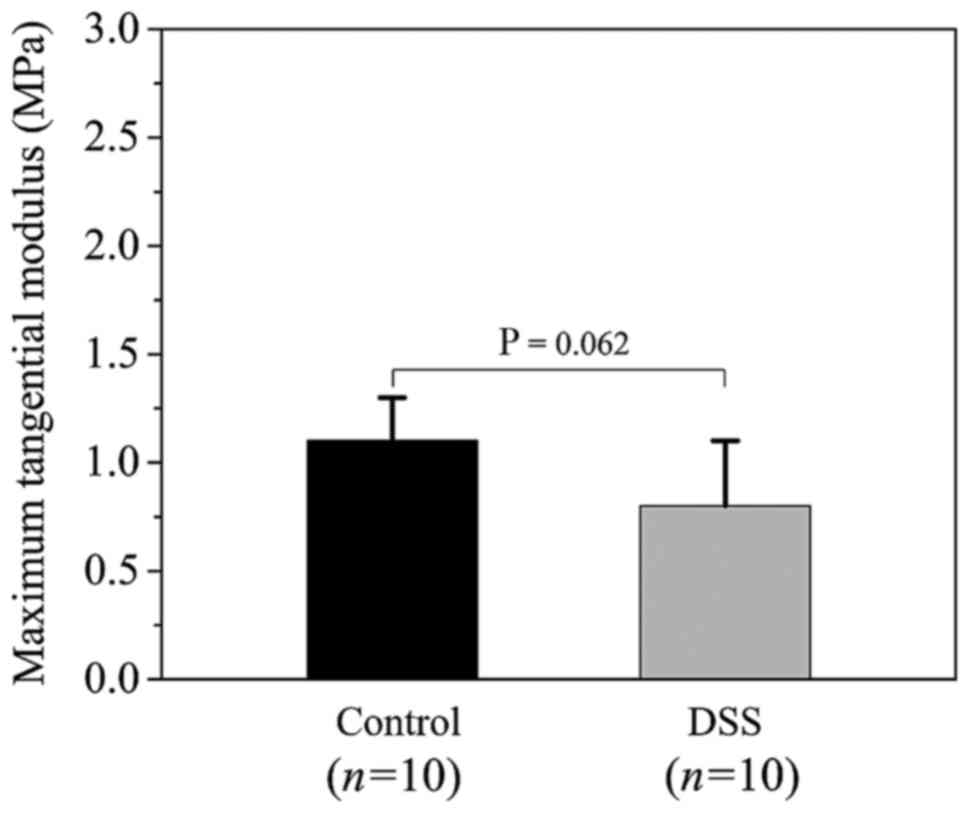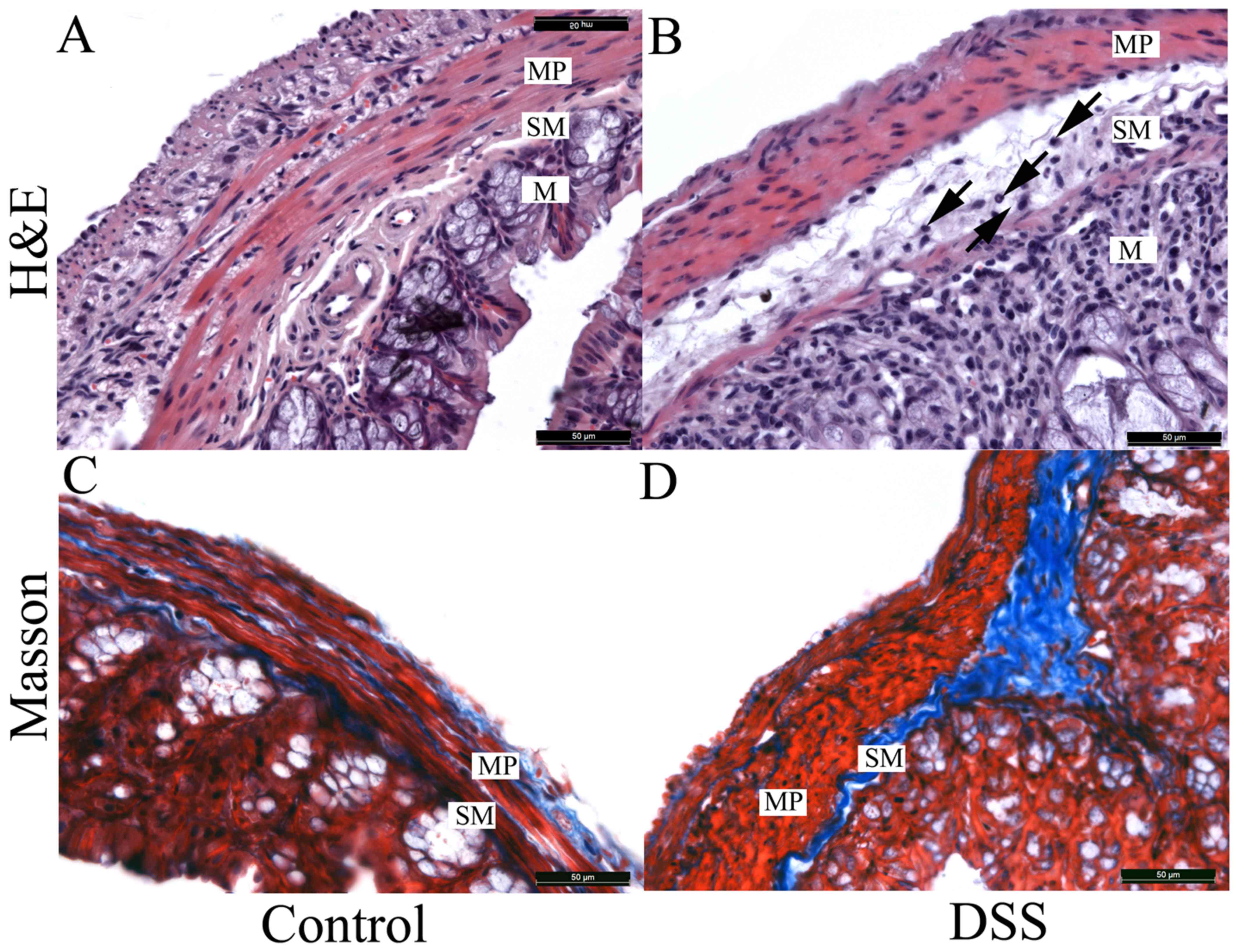Alterations in biomechanical properties and microstructure of colon wall in early-stage experimental colitis
- Authors:
- Published online on: June 14, 2017 https://doi.org/10.3892/etm.2017.4607
- Pages: 995-1000
-
Copyright: © Gong et al. This is an open access article distributed under the terms of Creative Commons Attribution License.
Abstract
Introduction
Ulcerative colitis (UC) and Crohn's disease (CD) are the most common types among chronic intestinal diseases (1). UC is a chronic relapsing-remitting inflammatory disorder that affects the colon and rectum. Unlike CD, UC is a mucosal disease that always affects the rectum, and can spread up to the cecum with a continuous retrograde distribution (2). Although it is widely accepted that UC derives from the presence of a susceptibility gene, mucosal immunological disorders, colony dysbiosis and environmental risk factors, the exact underlying etiology remains unknown (3). UC may occur from infancy onwards, however, the risk increases greatly in early adulthood, slightly decreasing thereafter (4). In the past few decades, the incidence of UC has increased, particularly in developing nations. The major clinical manifestations of UC include abdominal pain, diarrhea, vomiting and weight loss in the patients' daily life (5,6). The hallmark clinical symptom of UC is bloody diarrhea (7). Furthermore, UC alters the absorption of water and electrolytes, and causes diarrhea in conjunction with the decline of colon tissue contraction.
One of the key mechanical contributions of colon tissues in vivo is to resist tensile forces to maintain structural stability and biological functionality. Therefore, previous studies have characterized the biomechanical properties of colon tissues (8–12). The colon wall is subject to tensile loading and finite strains, and in general, presents a nonlinear and anisotropic mechanical response (8,10,13). This is primarily owing to collagen fiber distribution within the microstructure of its subcomponents (14). Notably, the mechanical properties of biological soft tissue may be altered significantly in response to pathological changes (15). However, the potential effects of UC on the mechanical properties and microstructure of the colon wall remain largely unclear, and relevant quantitative mechanical data are lacking in the literature. Previous research has presented solid evidence that mice in a dextran sodium sulfate (DSS)-treated colitis model exhibit weight loss, bloody diarrhea, mucosal disorders and inflammation, resembling human UC (16–19). Given this aforementioned information, a biomechanical analysis of the colon wall in a mouse model of colitis induced by DSS may advance our understanding of changes in the complex structure-function association of tissues in response to colitis, particularly in the early stages of the disease.
In the present study, uniaxial tensile tests and histological investigations were performed on tissue samples from control and experimental colitis mice. The study aimed to clarify the intrinsic differences in ultimate tensile strength between these two tissue types, indicating the potential effects of colitis as a single pathological factor on the mechanical properties and microstructure of the colon wall.
Materials and methods
Animals
A total of 20 healthy 8-week-old C57BL/10J wild-type mice (weight, 25–35 g; 10 male and 10 female) were used in the present study. Mice were purchased from the Model Animal Research Center of Nanjing University (Nanjing, China), and were housed in the Experimental Animal Center at Tongji University (Shanghai, China). The animals were acclimatized to laboratory conditions (24±1°C, 12-h light/dark cycle, 55% humidity and ad libitum access to food and water) for two weeks prior to experimentation. All experimental procedures conformed to the International Guidelines for the Care and Use of Laboratory Animals and were approved by the Animal Ethics Committee of Tongji University School of Medicine (Shanghai, China).
Experimental colitis and animal groups
The mice were randomly assigned into two groups (n=10 in each), including the control and DSS (experimental colitis group). Animals in the control group animals consumed ddH20 orally, while colitis was induced in the DSS group by the oral administration of 4% DSS (MW=36,000–50,000; cat. no. 160110; MP Biomedicals, Solon, OH, USA) for 7 days continuously, as described by Li et al (20). At 7 days after the induction of colitis, stool consistency and the presence of occult blood was examined and documented daily.
Colitis score
Colonic damage was assessed by the macroscopic score (MS), based on three parameters as follows: i) Weight loss; ii) colon length shortening; and iii) occult blood. Each parameter was scored with between 0 and 4 points. The MS was the sum of the three scores, ranging between 0 (healthy) and 12 (maximal). Scoring was conducted as reported previously by Li et al (20) and Kimball et al (21).
Specimen preparations
All animals were euthanized by cervical dislocation on day 8 after colitis induction and the entire gut was carefully dissected. The colon, starting at 10 mm away from the cecum, was cut out at a length of 30 mm and weighed. Next, the colon was then dissected into two portions, including specimens of 20 mm (sample 1) for use in mechanical tests and 10 mm (sample 2) for histological analysis (Fig. 1). Sample 1 was stored at −80°C for the biomechanical tests, while sample 2 was immediately fixed in 4% paraformaldehyde for paraffin embedding. In total, 10 control and 10 DSS tissue samples were collected. The thicknesses of colon walls were measured by a micrometer.
For biomechanical tests, the cleaned colon was cut open axially (Fig. 2). Using a scalpel, a rectangular tissue specimen of 20×4 mm (lengthxwidth) was further extracted. The circumference of the mouse colon is 4.5–5.0 mm; therefore, a uniaxial tensile test could not be performed using a circumferential strip. In the present study, all rectangular strips were obtained from the axial direction. Sandpaper was mounted at the two ends of the prepared strip specimens with super-adhesive gel in order to facilitate defined clamping in the tensile testing machine and to prevent slippage during testing. In addition, two black straw chips (used as gauge markers for measuring deformation) were glued transversely in parallel onto the middle part of the specimens to function as gauge markers for the axial deformation measurements. The strip specimens were left to equilibrate in phosphate-buffered physiological saline with ethylene glycol tetraacetic acid at 37°C for ~15 min prior to mechanical testing.
For histological investigations, the fixed colon tissue was thoroughly washed with phosphate-buffered physiological saline. The samples were embedded in paraffin and cut into 5-µm sections on a Leica RM2126 microtome (Leica Microsystems, Shanghai, China). The sections were deparaffinized and then stained with hematoxylin and eosin (cat. nos. 842 and 837; Anatech Ltd., Battle Creek, MI, USA), and Masson staining (cat. no. HT15; Sigma-Aldrich; Merck, Darmstadt, Germany).
Mechanical testing
Uniaxial tensile tests were performed on a computer-controlled, screw-driven, high-precision tensile testing device adapted for small biological specimens (XJ810-10N; Xiangjie Instrument Technology Co., Ltd., Shanghai, China). The entire test was conducted in a Perspex container filled with 0.9% physiological saline solution maintained at 37.0±1.0°C by a heater-circulation unit (Ecoline E 200; Lauda, Lauda-Königshofen, Germany). Preconditioning was achieved by conducting five loading and unloading cycles at a constant extension rate of 0.5 mm/min to reach 75 kPa (which is the first Piola-Kirchhoff stress) for each test. After preconditioning was completed, the sample thickness was measured by means of a video extensometer, as described in earlier studies (22,23). Starting from the sixth tensile cycle, the strain was increased with the same extension rate of 0.5 mm/min until tissue rupture occurred. The rupture forces and associated stretches were documented.
Data analysis
The ultimate tensile stresses were computed according to the following formula: σult = fruptureλult/WT, where frupture is the rupture force, λult is the ultimate stretch, and W and T are the width and the thickness of the specimen in the unloaded configuration, respectively. The λult was defined as l/L, where l and L are the gauge lengths in the loaded (state at rupture) and unloaded configurations, respectively. In addition, the maximum tangential modulus (MTM), defined as the slope of the non-linear stress-stretch curve at the maximum load in preconditioning, was calculated and further averaged to assess the stiffness of the colon tissue under the same stress state (i.e., the first Piola-Kirchhoff stress PLL = 75 kPa).
Statistical analysis
Experimental data are summarized as the mean ± standard deviation. The Shapiro-Wilk and the Kolmogorov-Smirnov tests were used to determine data normality. Comparisons of quantitative values between the control and colitis groups were performed using the Student's t-test and χ2 test. Differences with a P-value of <0.05 were determined as statistically significant. Statistical analyses were performed using SPSS 21.0 statistical software (IBM Corp., Armonk, NY, USA).
Results
Mouse model observations
The DSS group began to develop diarrhea at day 3, and the following day, occult blood was observed in the stools of the mice. At day 5, all DSS-treated mice experienced diarrhea and hematochezia. By contrast, the control group presented no abnormal indications. The total MS for the DSS group was 9.6±0.9 (Fig. 3). However, the MS of the control group was 0. This demonstrated that successive challenges with DSS induced evident experimental colitis in the DSS group, with significant pathological alterations, including weight loss, colon length shortening and occult blood.
Thicknesses of the colon wall
The mean thicknesses of the colon walls for the control and the DSS groups were 90±10 and 110±30 µm, respectively, which were significantly different (P=0.08). In general, the colon wall in the DSS group was thicker as compared with that of the control group, possibly due to tissue edema.
Biomechanical tests
The preconditioning behavior of the colon tissue in the control and DSS groups is shown in Fig. 4, in terms of the Cauchy stress against the stretch. Each sample has five loading-unloading cycles. The tensile stress-stretch curves were highly nonlinear. Subsequently, the Shapiro-Wilk and the Kolmogorov-Smirnov tests demonstrated that the quantified ultimate tensile stress, stretch and MTM values were normally distributed. Differences in ultimate tensile stresses are demonstrated in Fig. 5. The ultimate tensile stresses were 232±33 and 183±25 kPa in the control and the DSS groups, respectively (P=0.001). This indicated that the ultimate tensile strength of the colon tissue was significantly decreased in the DSS group compared with the control group. In addition, the ultimate stretches at rupture for the control and DSS groups (not shown in figure) were 1.43±0.04 and 1.51±0.06, respectively (P=0.006). Thus, the rupture stretch for the DSS group was significantly higher compared with that of the control group. Statistical comparison of the MTM values between the control and DSS groups is presented in Fig. 6. The MTM values were 1.1±0.2 and 0.8±0.3 MPa for the control and the DSS groups, respectively (P=0.062), suggesting that there was no statistically significant difference in tissue stiffness of the colon wall between the two groups.
Histology
The microstructural characteristics of colon tissues in the two groups are demonstrated in Fig. 7A. Compared with the control group, a series of significant pathological changes were observed in the microstructure of the DSS group (Fig. 7B). In the mucosa, numerous inflammatory cells had infiltrated into the stroma and the structure of gland, to a certain extent, was destroyed. A similar phenomenon was also observed within the submucosa, with inflammatory cells infiltrating into the stroma, leading to a significant submucosa edema (arrows in Fig. 7B). However, inflammatory cells were not present in the muscularis propria. The entire thickness of the colon wall was increased in the DSS group, partly due to the edema of the submucosa.
In the control group, Masson staining revealed that the collagen fibers were tightly packed into bundles that surrounded the smooth muscle cells in the muscularis propria (Fig. 7C). By contrast, collagen fibers (blue) in the DSS-treated submucosa (Fig. 7D) demonstrated hyperplasia, and the fiber alignment was disordered. Notably, a large number of collagen fibers in the DSS-treated muscular layer were disrupted and fiber bundles were thinner when compared with the control group (Fig. 7C and D).
Discussion
In the present study, biomechanical tests and histological investigations were performed using a mouse colitis model to elucidate alterations in the mechanical properties and microstructure of colon tissues in response to early-stage of experimental colitis. In particular, it was attempted to establish a correlation between the mechanical data and structural characteristics.
Previous studies have induced UC using a variety of methods, including acetic acid, carrageenan, DSS, dinitrochlorobenzene and others agents (5,18). Among these protocols, the oral administration of DSS is regarded as the most effective method to generate UC since it is easy to repeat and has a high success rate. Thus, DSS is specifically appropriate for investigations of UC pathogenesis. The current results confirmed that uptake of 4% DSS in drinking water for 7 days caused colitis with typical manifestations, including colonic epithelia damage and submucosal edema, along with bloody stool and shortened colon, followed by body weight loss.
Under uniaxial tensile loadings, colon walls show pronounced nonlinear mechanical behavior with small hysteresis. The stress-stretch curves are characterized by an initially flat region and a subsequent steep region, which is typical for collagen-rich biological soft tissues (24,25). Biomechanical analysis in the present study confirmed that DSS-induced colitis has strong effects on the mechanical properties of colon tissues. The ultimate tensile strength of DSS-treated colon tissues was significantly lower in comparison with that of the control samples. This may be attributed to notable changes in microstructural characteristics under pathological conditions. As a load-bearing component, the muscular layer is responsible for the mechanical behavior of the intact colon wall when subjected to tensile loading (8,10,13,26). Histological analysis in the present study revealed that a large number of collagen fibers were disrupted in the DSS-treated muscular layer, contributing to a lower ultimate tensile strength and eventual tissue rupture. Furthermore, thinner fiber bundles in the DSS-treated samples may have a higher propensity to cause tissue defects on the microscale level during extension and further affect ultimate tensile strength. Experimental data in the current study demonstrated that the DSS-treated tissues were, in general, more extensible as compared with the control tissues at the same stress level. This may partially be explained by the pronounced hyperplasia of collagen fibers in the DSS-treated submucosa. Notably, hyperplasia of collagen may directly or indirectly influence adhesion, alignment and stretches of fiber bundles, and, therefore, serve a key role in tissue remodeling during pathological processes. In particular, fiber realignment within the DSS-treated submucosa may lead to a more disorganized microstructure, and, thus, will induce changes in the mechanical anisotropy of the colon wall. These factors potentially alter the extensibility of tissues. Although there was no statistically significant difference in tissue stiffness of the colon wall between the control and DSS groups in the present study, the mean MTM value for the DSS group was decreased when compared with the control group. This indicates that the colon wall is more compliant, rather than stiff, when it is initially susceptible to experimental colitis.
Histopathological analysis has demonstrated that intestinal fibrosis is a common complication of DSS-induced colitis and results in a stiff fibrotic colon that cannot perform peristalsis or resorb fluids, which are the major functions of the large bowel (18,27,28). Therefore, intestinal fibrosis frequently leads to abdominal pain and diarrhea. It should be emphasized that fibrosis mainly affects the submucosa layer. In the present study, however, a pronounced fibrosis of colon wall was not observed in the early stages, which was in accordance with previous studies (27,28).
In general, the quantified values of ultimate tensile strength and stretch were lower in the current study as compared with mechanical data obtained in previous studies (8,12,13,29). The discrepancy may be, in part, due to the experimental methods and sample types used herein. In the present study, a uniaxial tensile test was conducted to the intact colon wall subsequent to cutting it open. However, previous experimental investigations (8,13,29) used a pressure-inflation protocol to quantitatively determine mechanical properties. These methods represent two different deformations of the colon wall. In addition, the majority of previous studies (8,13,29) used rat colon or large intestine for mechanical tests, whereas the present experiments used mouse colon tissues.
The current study had certain limitations. Firstly, due to the small sample size of mouse colon, uniaxial tensile tests based on the circumferential strip specimen could not be performed. Therefore, it was not possible to measure the ultimate tensile strength and stretch of the colon wall in the circumferential direction. Secondly, the mouse colitis model represents a pathological state of the colon wall in the early stages of experimental colitis. This comparative study can only interpret changes in mechanical properties and microstructural characteristics of the colon wall with respect to early experimental colitis. As a single pathological factor, early experimental colitis has been demonstrated to alter the mechanical properties and microstructure of colon walls.
In conclusion, the ultimate tensile strength of the colon wall was significantly decreased during early-stage colitis. In response to the same tensile loads, the colon was more extensible as compared with that in the controls. However, there was no statistically significant difference in tissue stiffness between the DSS and control groups. Compared with the microstructure of the healthy colon wall, it was observed that a large number of collagen fibers were disrupted within the DSS-treated muscular layer. Furthermore, hyperplasia was identified in the DSS-treated submucosa, causing a disorganized microstructure within the colon wall. These findings provide an additional perspective into the effects of DSS-induced colitis on the mechanical properties and microstructure of the colon wall, and may be helpful for the interpretation of UC pathogenesis in future studies.
Acknowledgements
The present study was supported by grants from the Program for Young Excellent Talents at Tongji University (grant no. 1500219086) and the Fundamental Research Funds (grant nos. 1500219085 and 1500219095) for the Central Universities, China. The authors are also grateful for funding provided by the National Natural Science Foundation of China (grant nos. 81100091 and 31571181) and the Shanghai Municipal Commission of Health and Family Planning (grant no. 20134Y33).
References
|
Baumgart DC and Carding SR: Inflammatory bowel disease: Cause and immunobiology. Lancet. 369:1627–1640. 2007. View Article : Google Scholar : PubMed/NCBI | |
|
Di Sabatino A, Biancheri P, Rovedatti L, Macdonald TT and Corazza GR: Recent advances in understanding ulcerative colitis. Intern Emerg Med. 7:103–111. 2012. View Article : Google Scholar : PubMed/NCBI | |
|
Adams SM and Bornemann PH: Ulcerative Colitis. Am Fam Physician. 87:699–705. 2013.PubMed/NCBI | |
|
Herrinton LJ, Liu L, Lewis JD, Griffin PM and Allison J: Incidence and prevalence of inflammatory bowel disease in a Northern California managed care organization, 1996–2002. Am J Gastroenterol. 103:1998–2006. 2008. View Article : Google Scholar : PubMed/NCBI | |
|
Rijnierse A, Nijkamp FP and Kraneveld AD: Mast cells and nerves tickle in the tummy: Implications for inflammatory bowel disease and irritable bowel syndrome. Pharmacol Ther. 116:207–235. 2007. View Article : Google Scholar : PubMed/NCBI | |
|
Choi SY, Hur SJ, An CS, Jeon YH, Jeoung YJ, Bak JP and Lim BO: Anti-inflammatory effects of Inonotus obliquus in colitis induced by dextran sodium sulfate. J Biomed Biotechnol. 2010:9435162010. View Article : Google Scholar : PubMed/NCBI | |
|
da Silva BC, Lyra AC, Rocha R and Santana GO: Epidemiology, demographic characteristics and prognostic predictors of ulcerative colitis. World J Gastroenterol. 20:9458–9467. 2014.PubMed/NCBI | |
|
Watters DA, Smith AN, Eastwood MA, Anderson KC and Elton RA: Mechanical properties of the rat colon: The effect of age, sex and different conditions of storage. Q J Exp Physiol. 70:151–162. 1985. View Article : Google Scholar : PubMed/NCBI | |
|
Watters DA, Smith AN, Eastwood MA, Anderson KC, Elton RA and Mugerwa JW: Mechanical properties of the colon: Comparison of the features of the African and European colon in vitro. Gut. 26:384–392. 1985. View Article : Google Scholar : PubMed/NCBI | |
|
Egorov VI, Schastlivtsev IV, Prut EV, Baranov AO and Turusov RA: Mechanical properties of the human gastrointestinal tract. J Biomech. 35:1417–1425. 2002. View Article : Google Scholar : PubMed/NCBI | |
|
Rosen J, Brown JD, De S, Sinanan M and Hannaford B: Biomechanical properties of abdominal organs in vivo and postmortem under compression loads. J Biomech Eng. 130:0210202008. View Article : Google Scholar : PubMed/NCBI | |
|
Howes MK and Hardy WN: Material properties of the post-mortem colon in high-rate equibiaxial elongation. Biomed Sci Instrum. 48:171–178. 2012.PubMed/NCBI | |
|
Gao C and Gregersen H: Biomechanical and morphological properties in rate large intestine. J Biomech. 33:1089–1097. 2000. View Article : Google Scholar : PubMed/NCBI | |
|
Carniel EL, Gramigna V, Fontanella CG, Stefanini C and Natali AN: Constitutive formulations for the mechanical investigation of colonic tissues. J Biomed Mater Res A. 102:1243–1254. 2014. View Article : Google Scholar : PubMed/NCBI | |
|
Humphrey JD: Cardiovascular Solid Mechanics. Cells, Tissues and Organs. Springer-Verlag; New York: 2002 | |
|
Okumura R, Kurakawa T, Nakano T, Kayama H, Kinoshita M, Motooka D, Gotoh K, Kimura T, Kamiyama N, Kusu T, et al: Lypd8 promotes the segregation of flagellated microbiota and colonic epithelia. Nature. 532:117–121. 2016. View Article : Google Scholar : PubMed/NCBI | |
|
Elinav E, Strowig T, Kau AL, Henao-Mejia J, Thaiss CA, Booth CJ, Peaper DR, Bertin J, Eisenbarth SC, Gordon JI and Flavell RA: NLRP6 inflammasome regulates colonic microbial ecology and risk for colitis. Cell. 145:745–757. 2011. View Article : Google Scholar : PubMed/NCBI | |
|
Hao XP, Lucero CM, Turkbey B, Bernardo ML, Morcock DR, Deleage C, Trubey CM, Smedley J, Klatt NR, Giavedoni LD, et al: Experimental colitis in SIV-uninfected rhesus macaques recapitulates important features of pathogenic SIV infection. Nat Commun. 6:80202015. View Article : Google Scholar : PubMed/NCBI | |
|
Zhou X, Cao L, Jiang C, Xie Y, Cheng X, Krausz KW, Qi Y, Sun L, Shah YM, Gonzalez FJ, et al: PPARα-UGT axis activation represses intestinal FXR-FGF15 feedback signalling and exacerbates experimental colitis. Nat Commun. 5:45732014. View Article : Google Scholar : PubMed/NCBI | |
|
Li YY, Yuece B, Cao HM, Lin HX, Lv S, Chen JC, Ochs S, Sibaev A, Deindl E, Schaefer C and Storr M: Inhibition of p38/Mk2 signaling pathway improves the anti-inflammatory effect of WIN55 on mouse experimental colitis. Lab Invest. 93:322–333. 2013. View Article : Google Scholar : PubMed/NCBI | |
|
Kimball ES, Wallace NH, Schneider CR, D'Andrea MR and Hornby PJ: Vanilloid receptor 1 antagonists attenuate disease severity in dextran sulphate sodium-induced colitis in mice. Neurogastroenterol Motil. 16:811–818. 2004. View Article : Google Scholar : PubMed/NCBI | |
|
Holzapfel GA, Sommer G, Gasser CT and Regitnig P: Determination of the layerspecific mechanical properties of human coronary arteries with nonatherosclerotic intimal thickening and related constitutive modelling. Am J Physiol Heart Circ Physiol. 289:H2048–H2058. 2005. View Article : Google Scholar : PubMed/NCBI | |
|
Tong J, Sommer G, Regitnig P and Holzapfel GA: Dissection properties and mechanical strength of tissue components in human carotid bifurcations. Ann Biomed Eng. 39:1703–1719. 2011. View Article : Google Scholar : PubMed/NCBI | |
|
Holzapfel GA: Nonlinear Solid Mechanics. A Continuum Approach for Engineering. 1st. John Wiley & Sons; Chichester: 2000 | |
|
Holzapfel GA, Gasser TC and Ogden RW: A new constitutive framework for arterial wall mechanics and a comparative study of material models. J Elasticity. 61:1–48. 2000. View Article : Google Scholar | |
|
Gregerson H: Biomechanics of the Gastrointestinal TractNew Prospectives in Motility Research and Diagnostics. Springer-Verlag; London: 2003 | |
|
Quigley EM: What we have learned about colonic motility: Normal and disturbed. Curr Opin Gastroenterol. 26:53–60. 2010. View Article : Google Scholar : PubMed/NCBI | |
|
Bassotti G, Villanacci V, Mazzocchi A, Castellani D, Giuliano V, Corsi S and Morelli A: Colonic propulsive and postprandial motor activity in patients with ulcerative colitis in remission. Eur J Gastroenterol Hepatol. 18:507–510. 2006. View Article : Google Scholar : PubMed/NCBI | |
|
Sokolis DP, Orfanidis IK and Peroulis M: Biomechanical testing and material characterization for rat large intestine: Regional dependency of material parameters. Physiol Meas. 32:1969–1982. 2011. View Article : Google Scholar : PubMed/NCBI |



